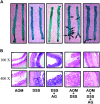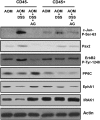Mechanistic insight into the ability of American ginseng to suppress colon cancer associated with colitis
- PMID: 20729391
- PMCID: PMC2950936
- DOI: 10.1093/carcin/bgq163
Mechanistic insight into the ability of American ginseng to suppress colon cancer associated with colitis
Abstract
We have recently shown that American ginseng (AG) prevents and treats mouse colitis. Because both mice and humans with chronic colitis have a high colon cancer risk, we tested the hypothesis that AG can be used to prevent colitis-driven colon cancer. Using the azoxymethane (AOM)/dextran sulfate sodium (DSS) mouse model of ulcerative colitis, we show that AG can suppress colon cancer associated with colitis. To explore the molecular mechanisms of the anticancer effects of AG, we also carried out antibody array experiments on colon cells isolated at a precancerous stage. We found there were 82 protein end points that were either significantly higher (41 proteins) or significantly lower (41 proteins) in the AOM + DSS group compared with the AOM-alone (control) group. In contrast, there were only 19 protein end points that were either significantly higher (10 proteins) or significantly lower (9 proteins) in the AOM + DSS + AG group compared with the AOM-alone (control) group. Overall, these results suggest that AG keeps the colon environment in metabolic equilibrium when mice are treated with AOM + DSS and gives insight into the mechanisms by which AG protects from colon cancer associated with colitis.
Figures



Similar articles
-
Chemopreventive Activity of Red Ginseng Oil in a Mouse Model of Azoxymethane/Dextran Sulfate Sodium-Induced Inflammation-Associated Colon Carcinogenesis.J Med Food. 2019 Jun;22(6):578-586. doi: 10.1089/jmf.2018.4328. Epub 2019 Mar 13. J Med Food. 2019. PMID: 30864851
-
Role of intestinal microbiome in American ginseng-mediated colon cancer prevention in high fat diet-fed AOM/DSS mice [corrected].Clin Transl Oncol. 2018 Mar;20(3):302-312. doi: 10.1007/s12094-017-1717-z. Epub 2017 Aug 14. Clin Transl Oncol. 2018. PMID: 28808878 Free PMC article.
-
Suppression of colitis-driven colon cancer in mice by a novel small molecule inhibitor of sphingosine kinase.Carcinogenesis. 2010 Oct;31(10):1787-93. doi: 10.1093/carcin/bgq158. Epub 2010 Aug 5. Carcinogenesis. 2010. PMID: 20688834 Free PMC article.
-
Chemopreventive Effect of Aster glehni on Inflammation-Induced Colorectal Carcinogenesis in Mice.Nutrients. 2018 Feb 12;10(2):202. doi: 10.3390/nu10020202. Nutrients. 2018. PMID: 29439531 Free PMC article.
-
Murine Model for Colitis-Associated Cancer of the Colon.Methods Mol Biol. 2016;1438:245-54. doi: 10.1007/978-1-4939-3661-8_14. Methods Mol Biol. 2016. PMID: 27150094 Free PMC article. Review.
Cited by
-
Colon cancer and the epidermal growth factor receptor: Current treatment paradigms, the importance of diet, and the role of chemoprevention.World J Clin Oncol. 2015 Oct 10;6(5):133-41. doi: 10.5306/wjco.v6.i5.133. World J Clin Oncol. 2015. PMID: 26468449 Free PMC article. Review.
-
The role and place of medicinal plants in the strategies for disease prevention.Afr J Tradit Complement Altern Med. 2013 Aug 12;10(5):210-29. doi: 10.4314/ajtcam.v10i5.2. Afr J Tradit Complement Altern Med. 2013. PMID: 24311829 Free PMC article. Review.
-
Trends in ginseng research in 2010.J Ginseng Res. 2011 Nov;35(4):389-98. doi: 10.5142/jgr.2011.35.4.389. J Ginseng Res. 2011. PMID: 23717084 Free PMC article.
-
A key role of microRNA-29b for the suppression of colon cancer cell migration by American ginseng.PLoS One. 2013 Oct 9;8(10):e75034. doi: 10.1371/journal.pone.0075034. eCollection 2013. PLoS One. 2013. PMID: 24130681 Free PMC article.
-
Ginsenoside Rh2 inhibits human A172 glioma cell proliferation and induces cell cycle arrest status via modulating Akt signaling pathway.Mol Med Rep. 2018 Feb;17(2):3062-3068. doi: 10.3892/mmr.2017.8193. Epub 2017 Dec 5. Mol Med Rep. 2018. PMID: 29207171 Free PMC article.
References
-
- Lennard-Jones JE, et al. Cancer surveillance in ulcerative colitis. Experience over 15 years. Lancet. 1983;2:149–152. - PubMed
-
- Lashner BA, et al. Colon cancer surveillance in chronic ulcerative colitis: historical cohort study. Am. J. Gastroenterol. 1990;85:1083–1087. - PubMed
-
- Kiesslich R, et al. Methylene blue-aided chromoendoscopy for the detection of intraepithelial neoplasia and colon cancer in ulcerative colitis. Gastroenterology. 2003;124:880–888. - PubMed
-
- Askling J, et al. Family history as a risk factor for colorectal cancer in inflammatory bowel disease. Gastroenterology. 2001;120:1356–1362. - PubMed
-
- Rubin DT, et al. Colorectal cancer prevention in inflammatory bowel disease and the role of 5-aminosalicylic acid: a clinical review and update. Inflamm. Bowel Dis. 2008;14:265–274. - PubMed
Publication types
MeSH terms
Substances
Grants and funding
LinkOut - more resources
Full Text Sources
Other Literature Sources
Medical
Molecular Biology Databases

